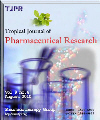
|
Tropical Journal of Pharmaceutical Research
Pharmacotherapy Group, Faculty of Pharmacy, University of Benin, Benin City, Nigeria
ISSN: 1596-5996
EISSN: 1596-5996
Vol. 14, No. 5, 2015, pp. 845-851
|
 Bioline Code: pr15111
Bioline Code: pr15111
Full paper language: English
Document type: Research Article
Document available free of charge
|
|
|
Tropical Journal of Pharmaceutical Research, Vol. 14, No. 5, 2015, pp. 845-851
| en |
Quantitation of Solifenacin in Human Plasma using a Specific and Sensitive Liquid Chromatography-Tandem Mass Spectrometry Technique
Ammari, Wesam G.
Abstract
Purpose: The current work validated a high performance liquid chromatography-tandem mass
spectrometric (HPLC-MS/MS) bioassay method developed in-house for the quantitation of solifenacin in
human plasma.
Methods: Solifenacin was extracted from plasma by a liquid-liquid extraction (LLE) technique using tertbutyl
methyl ether. The dry extract was then reconstituted with 200 μL of the mobile phase (acetonitrilewater
(80:20, v/v)). Solifenacin-d5 was the internal standard (IS). Elution was carried out on a C18
column at a flow rate of 1 mL/min. The MS/MS employed turbo-ion spray ionization in the positive ion
mode. Solifenacin and IS were monitored at a mass to charge ratio (m/z) of 363.4 and 368.4,
respectively. Bioassay validation followed International Bioanalytical Method Validation Guidelines.
Results: The validated calibration curves were linear over a range of 0.5 – 60.0 ng/mL (regression
factors ≥ 0.9994). Method specificity was established in 6 different human plasma batches. Intra- and
inter-day precision and accuracy were within ± 20 % (for lower limit of quantitation (LLOQ)) and ± 15 %
(for low, mid and high quality control (QC) levels). Short- and long-term stability was within accepted
range.
Conclusion: A specific, accurate and precise HPLC-MS/MS method has been validated for the
determination of solifenacin in human plasma.
Keywords
Liquid extraction; Mass spectrometry; Solifenacin; Validation
|
| |
© Copyright 2015 - Tropical Journal of Pharmaceutical Research
Alternative site location: http://www.tjpr.org
|
|
